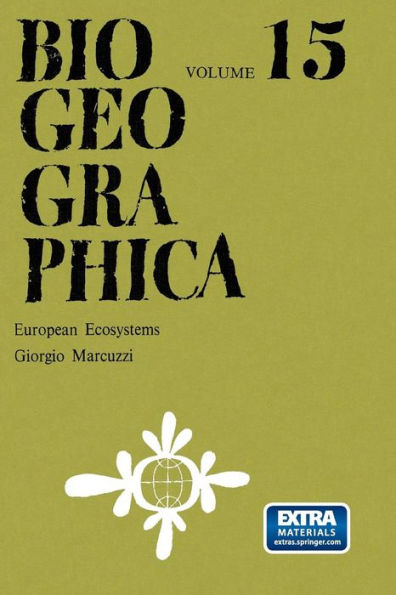5
1


Paperback(Softcover reprint of the original 1st ed. 1979)
$109.99
-
PICK UP IN STORECheck Availability at Nearby Stores
Available within 2 business hours
Related collections and offers
109.99
In Stock
Overview
There are many works, written in several European languages, on general, animal, and more especially vegetational ecology, but the space devoted to the study and description of the various ecosystems - both terrestrial and aquatic - of Europe is very limited, and this even in the books of European workers. Indeed, today we are in the strange position that, while some extra-European continents or parts of continents such as South Africa, the west part of South American, Australia, the arid zones of the Old World, not to mention Antarctica (that recentlY has at- tracted the attention of a great number of students) have been very thoroughly studied and illustrated - for European ecosystems we have very scant informa- tion, if we make allowance for the many analytical works on single natural or artificial environments (generally belonging to Central or Northern Europe). We have a beautiful book on the animal ecology of Palestine (today comprising Israel plus Jordan) written in the mid-thirties by Bodenheimer. However, Palestine does not belong to Europe, although some of the ecological and geographical peculiar- ities of the western part of the country do correspond very closely to those of Southern Europe.

Product Details
| ISBN-13: | 9789400996182 |
|---|---|
| Publisher: | Springer Netherlands |
| Publication date: | 02/15/2014 |
| Series: | Biogeographica , #15 |
| Edition description: | Softcover reprint of the original 1st ed. 1979 |
| Pages: | 779 |
| Product dimensions: | 6.10(w) x 9.25(h) x 0.06(d) |
Table of Contents
Sclerophyllous Forest.- A. General part.- The climate.- The soil.- The vegetation.- Effects of man on the sclerophyllous forest.- The fauna of the sclerophyllous forest.- Vertebrates.- Invertebrates.- Parasites and poisonous animals in South Europe.- B. Special part.- Dalmatia.- Puglie and the Tremiti Islands.- The Aeolian Islands.- The islands of the ‘Sicilian Channel’.- Western Sicily and the Egadi.- The Island of Elba.- Banyuls-sur-Mer (Côte Vermeille).- The Deciduous Forest.- General characteristics.- Vegetation.- The effects of man on European deciduous forest.- The fauna of deciduous forests.- Mammals.- The birds.- Reptiles and amphibians.- The invertebrates.- Soil life in deciduous forests.- Harmful invertebrates of deciduous forests.- Dynamism in ecology of deciduous forests.- An example of conservation in the deciduous forests.- Examples of European deciduous forests.- Abruzzo: the region near Chieti.- Euganean Hills (Colli Euganei).- The Venetian Prealps.- The oak forests of South-Eastern England.- Moravia.- The Taiga.- General features.- The animal of the taiga.- The mammals.- The birds.- Amphibians and reptiles.- The invertebrates.- Animals of forest interest.- The soil fauna.- The problem of conservation.- The Tundra.- The tundra in the past.- The influence of human agency upon the tundra.- The vegetation.- The fauna.- Mammals.- The bird life of tundra.- Reptiles and amphibians.- The invertebrates.- Insects.- Soil fauna.- The problem of conservation in tundra ecosystems.- Applied ecology in the tundra ecosystem.- The Steppe.- The impact of man on the steppes.- The vegetation.- The fauna.- Mammals.- Birds.- Reptiles.- The invertebrates.- Phytophagous insects.- Soil fauna.- Productivity.- The Heaths.- Human impact upon heaths.- The vegetation.- Ecological implications of heath plants.- Origin of the heaths.- The heath animals.- The vertebrate fauna.- The invertebrates.- The soil fauna.- The epigeous fauna.- Elements of biogeographical interest within the heath fauna.- Conservation problems in heathland.- The Montane Environment.- The soil.- The impact of man upon the mountain environment.- The vegetation.- Animal life.- The vertebrates.- Mammals.- Birds.- Amphibians and reptiles.- The invertebrates.- The altitudinal distribution.- Alimentary or ‘functional’ categories.- Comments on Pyrenean invertebrates.- Comments on the Carpathians invertebrates.- Comments on the Caucasus invertebrates.- Zoogeography of mountain invertebrates.- Soil fauna.- Protection in the montane environment.- Humid or Alluvial Environments.- General characteristics.- Swamps.- Mountain swamps.- Moors.- ‘Flachmoore’.- Mountain ‘Flachmoore’.- ‘Hochmoore’.- The shores of lakes.- The banks of rivers.- Mountain rivers and brooks.- Life on the sea-shore.- Rocky shores.- Sandy shores.- Muddy shores.- The human impact upon humid environments.- Freshwater environments.- Sea-shores.- Conservation problems in humid environments.- Fresh Water Environments.- General characteristics.- The sediments.- Vegetation.- The impact of man on freshwater environments.- Standing waters.- Lakes.- Ponds.- Swamps.- Mires.- ‘Kleingewässer’.- Karst lakes.- ‘Marcite’.- Rice fields.- Brackish waters.- The Caspian Sea.- The Azov Sea.- Saltern.- Running waters.- Brooks.- Rivers.- The springs.- Fishing and fish culture in continental waters.- Pollution of inland waters.- The Environment of Human Settlement.- Artificial Ecosystems: The Cultivated Areas.- Addenda.- The sclerophyllous forest.- The deciduous forest.- The steppe.- The montane environment.- Humid or alluvial environments.- Fresh water environments.- The environment of human settlement.- Artificial ecosystems: the cultivated areas.From the B&N Reads Blog
Page 1 of
